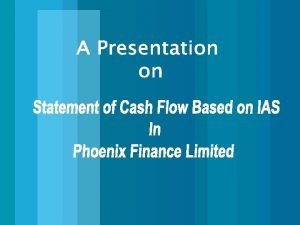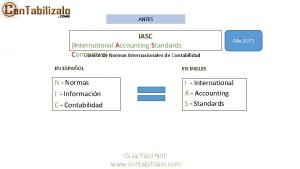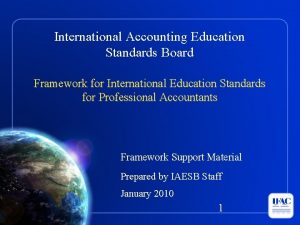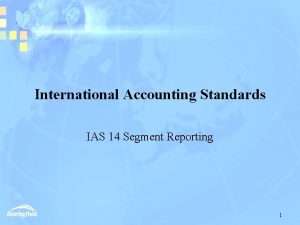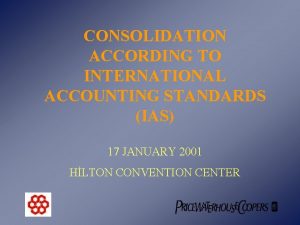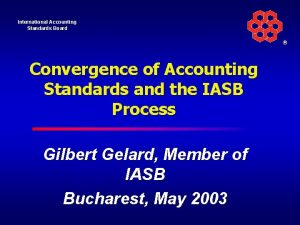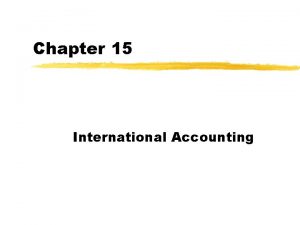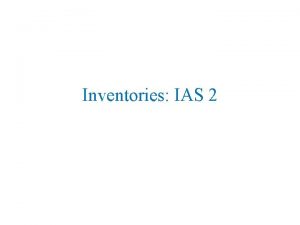International Accounting Standards IAS Standards for the preparation
















- Slides: 16


International Accounting Standards (IAS) Standards for the preparation and presentation of financial statements created by the International Accounting Standards Committee (IASC). They were first written in 1973, and stopped when the International Accounting Standards Board (IASB) took over their creation in 2001. See also Generally Accepted Accounting Principles (GAAP).

COMPANY PROFILE Former Phoenix Leasing Company Limited), one of the leading and reliable multi products Financial Institution in Bangladesh was incorporated in Bangladesh on April 19, 1995 as Public Limited Company under the Companies Act 1994 and started its operation on May 9 1995 as a Non Banking Financial Institution under Financial Institution Act 1993 , it has changed its name to Phoenix Finance & Investment Limited (PFIL) with a view to reflecting multi-dimensional financial activities the company has been doing other than Lease Financing which although , has remained as the prime area of the financial activities.

COMPANY VISION & MISSION Our Vision To act as the best financial service provider in the country. Our Mission. To provide multiple financial products and services. To provide entrepreneurship skills and enterprises . To promote employment generation and poverty alleviation . To accelerate the pace of industrialization for prosperous Bangladesh. To promote passion for posterity . To promote SME sector

Objective The objective of this Standard is to require the provision of information about the historical changes in cash and cash equivalents of an entity by means of a statement of cash flows which classifies cash flows during the period from operating, investing and financing activities.

Operating activities are the principal revenueproducing activities of the entity and other activities that are not investing or financing activities. Cash flows from operating activities are primarily derived from the principal revenueproducing activities of the entity. Therefore, they generally result from the transactions and other events that enter into the determination of profit or loss.

Investing activities are the acquisition and disposal of long-term assets and other investments not included in cash equivalents. The separate disclosure of cash flows arising from investing activities is important because the cash flows represent the extent to which expenditures have been made for resources intended to generate future income and cash flows.

Financing activities are activities that result in changes in the size and composition of the contributed equity and borrowings of the entity. The separate disclosure of cash flows arising from financing activities is important because it is useful in predicting claims on future cash flows by providers of capital to the entity.

Foreign currency cash flows Cash flows arising from transactions in a foreign currency shall be recorded in an entity's functional currency by applying to the foreign currency amount the exchange rate between the functional currency and the foreign currency at the date of the cash flow. The cash flows of a foreign subsidiary shall be translated at the exchange rates between the functional currency and the foreign currency at the dates of the cash flows.

Benefits of information on cash flows The cash flow statement, when used in conjunction with the rest of the financial statements, provides information that allows users to evaluate changes in net assets of the company, its financial structure (including its liquidity and solvency) and their ability to change both the amounts and dates of receipts and payments in order to adapt to changing circumstances and opportunities that may arise. Information about cash flows is useful for evaluating the capacity that the company has to generate cash and cash equivalents, allowing users to develop models to assess and compare the present value of net cash flows from different companies.

Presentation of the cash flow statement company presents its cash flows from operating activities, investing and financing, in the manner that is most appropriate to the nature of their activities. The classification of flows according to the above activities provide information that enables users to evaluate the impact of those in the financial position of the company, as well as on the final amount in its cash and other cash equivalents. This structure of information can also be useful in assessing the relationship between such activities.

Cash flows in foreign currency Cash flows from transactions in foreign currencies are translated into the functional currency of the entity applying to the amount in foreign currency, the exchange rate between two currencies on the date it occurred every stream in question

Interest and dividends The cash flows related to interest received and paid, as the dividends received and paid, must be disclosed separately. Each of the above items should be classified consistently, each year, as part of operating activities, investing and financing.

Income Taxes on profits in transactions classified as operating activities, investing or financing in the statement of cash flows. Although spending due on income taxes can easily be associated with certain activities of investment or financing, the cash flows associated with it are often impossible to identify and may arise in a year than the corresponding to the underlying transaction. Therefore, the taxes paid are usually classified as cash flows from operating activities.

Thank You For listening the Session.

 International accounting standards ias
International accounting standards ias Worldwide accounting diversity and international standards
Worldwide accounting diversity and international standards International accounting standards committee
International accounting standards committee International accounting education standards board
International accounting education standards board Financial accounting chapter 1
Financial accounting chapter 1 Kontinuitetshantering
Kontinuitetshantering Typiska drag för en novell
Typiska drag för en novell Nationell inriktning för artificiell intelligens
Nationell inriktning för artificiell intelligens Returpilarna
Returpilarna Shingelfrisyren
Shingelfrisyren En lathund för arbete med kontinuitetshantering
En lathund för arbete med kontinuitetshantering Underlag för särskild löneskatt på pensionskostnader
Underlag för särskild löneskatt på pensionskostnader Tidböcker
Tidböcker Sura för anatom
Sura för anatom Densitet vatten
Densitet vatten Datorkunskap för nybörjare
Datorkunskap för nybörjare Tack för att ni lyssnade bild
Tack för att ni lyssnade bild
